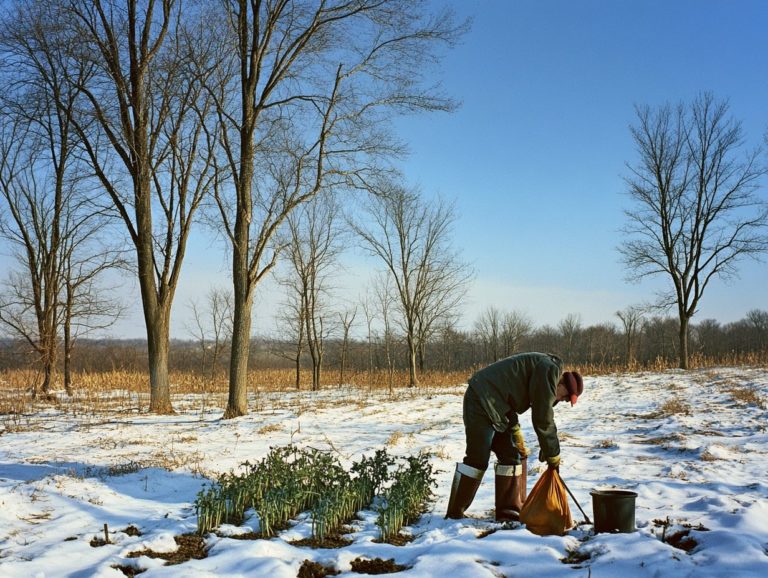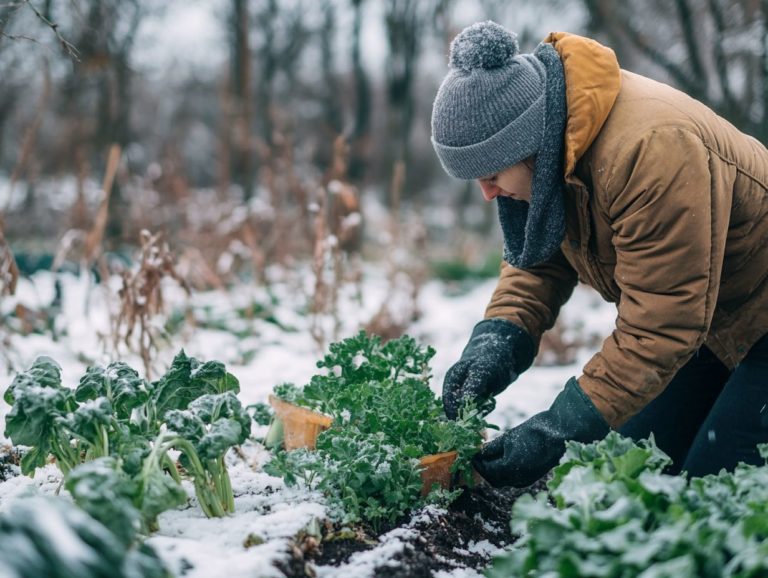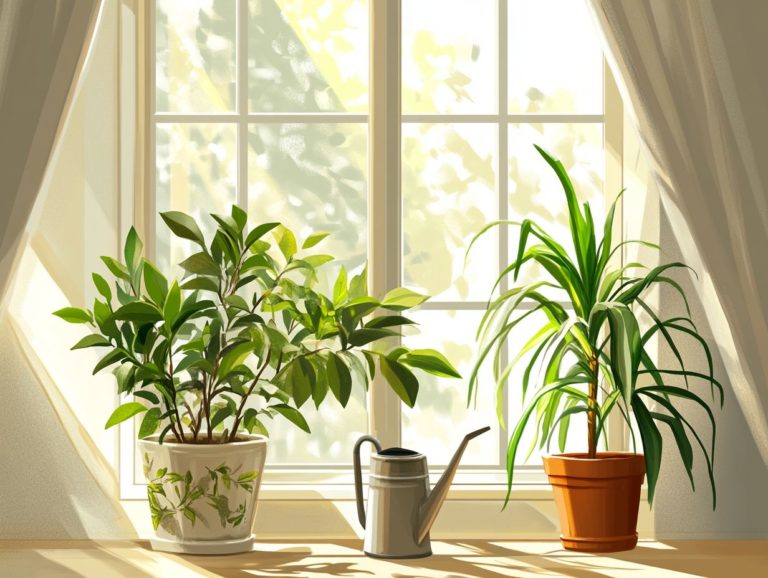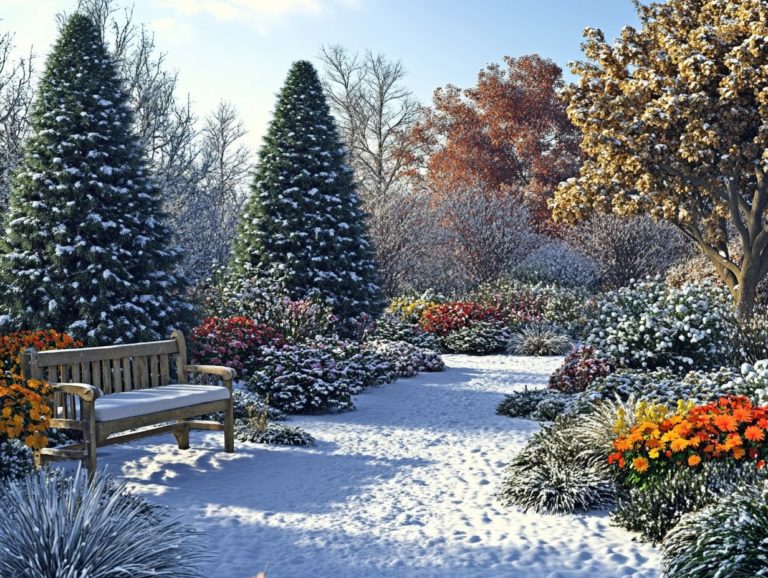How to Protect Your Crops from Freezing
As the temperature lowers, frost can be a big problem for both gardeners and farmers. Understanding freezing temperatures is crucial. It helps you safeguard your plants and crops from potential harm.
This article delves into how to recognize frost damage, preventative measures for frost protection, and effective emergency responses to rescue your harvest. It will also cover long-term strategies to cultivate a more favorable growing environment.
Arm yourself with the insights necessary to ensure your garden flourishes, even amidst the winter chill.
Contents
- Key Takeaways:
- Understanding Frost and Freezing Temperatures
- Preventative Measures for Frost Protection
- Emergency Response to Frost Damage
- Long-Term Strategies for Frost Protection
- Frequently Asked Questions
- What are some common ways to protect crops from freezing?
- How do row covers help protect crops from freezing?
- What type of mulch should I use to protect my crops from freezing?
- Can I use water to protect my crops from freezing?
- Do I need to cover my crops every time there is a freeze warning?
- Should I remove the covers after the freeze has passed?
Key Takeaways:
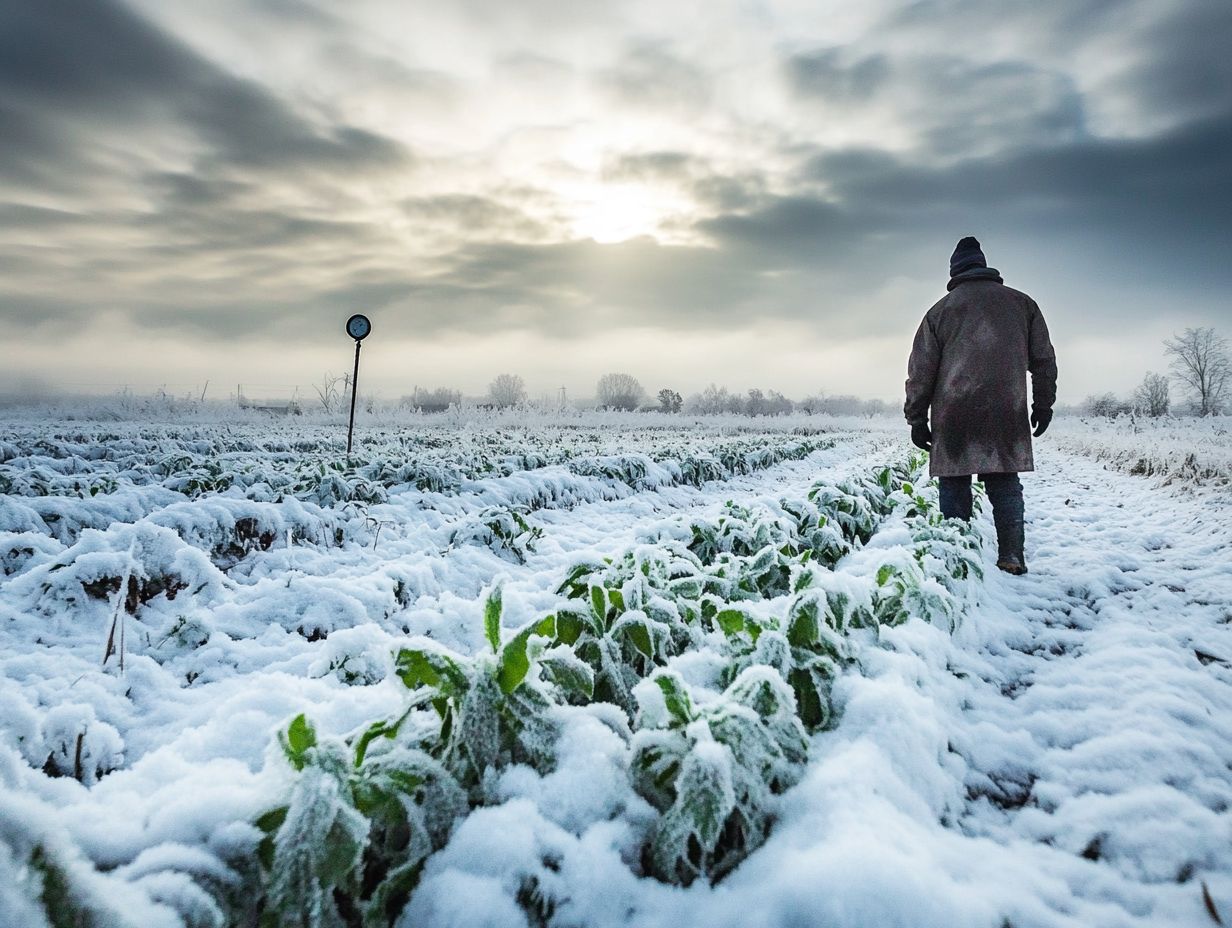
- Choose frost-resistant plant varieties and properly cover your crops to prevent damage from freezing temperatures.
- In case of frost damage, act quickly and use emergency techniques to save your crops or seek professional help if necessary.
- Create a thriving garden by developing a microclimate and adopting sustainable practices to protect your crops from frost damage in the future.
Understanding Frost and Freezing Temperatures
Understanding frost and freezing temperatures is essential for your winter gardening success, especially when it comes to protecting delicate plants like young plants and tender perennials.
In places like Florida, January can surprise you with unexpected frost, which can pose a significant threat to your garden’s health and longevity. By familiarizing yourself with how to identify freezing conditions and the specific temperatures that lead to frost damage, you can take proactive steps to shield your plants from the cold.
Acquiring this knowledge is crucial for anyone aiming to nurture a flourishing garden throughout the winter months.
What Causes Freezing?
Freezing happens when temperatures plunge below 32 F (0 C), leading to the formation of frost that can wreak havoc on delicate plants, especially those young plants you ve nurtured. A variety of factors humidity, wind, and your geographic location play a significant role in determining when and how frost forms. This can create quite a headache for you as a gardener trying to shield your tender plants.
Knowing these conditions is a game-changer for your garden! Frost starts to form when moisture in the air condenses and freezes on surfaces during those clear, calm nights, particularly in low-lying areas where cold air tends to settle. This process can be intensified by high humidity, since moisture levels dramatically influence the likelihood of frost forming. Wind, on the other hand, can have a mixed impact; while it may help disperse cold air, it can also prevent frost by mixing warmer air closer to the ground.
As a gardener, you need to stay alert. Specific geographic factors, such as altitude and the proximity to bodies of water, can also influence frost occurrence. By implementing protective measures like covers or windbreaks, you can significantly boost the chances of your plants thriving during those frigid conditions.
How to Identify Frost Damage
Identifying frost damage is crucial for safeguarding your plants and ensuring their longevity, especially for those tender varieties that are particularly vulnerable to freezing temperatures. You may notice signs of frost damage such as browning leaves, wilting, and stunted growth, all of which can jeopardize your garden’s health if not addressed swiftly. Recognizing these symptoms enables you to take immediate action to mitigate further damage.
Plus these obvious signs, keep an eye out for other visual indicators, like leaf discoloration, often manifesting as dark spots or necrotic tissue, especially in delicate species such as petunias and impatiens. Hardy plants, like certain perennials, might not show distress right away; instead, they may exhibit a delayed response, revealing signs of trouble only when the weather warms up. For example, case studies involving geraniums and hostas show how wilting can hint at deeper, unseen damage lurking beneath the surface.
It s essential for you to monitor temperatures closely during frost events and implement protective measures, like frost cloths, at the first sign of cold weather. Timely intervention not only helps preserve your plants but also maintains the overall beauty and aesthetics of your garden.
Act now to protect your garden from frost and ensure a vibrant bloom come spring!
Preventative Measures for Frost Protection
Implementing preventative measures for frost protection is essential for safeguarding your tender plants and ensuring a successful winter gardening experience. Strategies such as using protective coverings like fleece, cloche plants, and hoop tunnels can significantly mitigate the risk of frost damage.
Apply a layer of mulch in your garden to insulate the soil. This helps your plants thrive even as temperatures dip. By understanding and using these techniques well, you can make a notable difference in maintaining a healthy garden throughout the cold months.
Choosing the Right Plants and Varieties

Choosing the right plants and varieties is crucial for effective frost protection, especially when opting for frost-tolerant selections to elevate your winter gardening game. For instance, selecting hardy plants over their tender counterparts can significantly reduce risks when temperatures drop, ensuring your vegetable crops can thrive despite the chill.
Familiarity with your local climate conditions and specific plant tolerances gives you the power to make informed decisions in your garden design.
In colder regions, you’ll find varieties like kale, Brussels sprouts, and certain root vegetables flourishing, demonstrating remarkable resilience against frost while delivering nutritious harvests. When planning your seasonal planting, it s essential to keep average frost dates in mind. This allows for planting times that ensure maturation before the harsh cold sets in.
Taking the time to understand the small climate zones within your garden can profoundly influence plant health, as certain areas may offer more shelter from biting winds or heavy snow. By prioritizing these considerations, you can cultivate a vibrant winter landscape that not only withstands frost but also enriches the overall biodiversity of your outdoor space.
Protective Coverings and Techniques
Utilizing protective coverings and techniques is essential for frost protection, especially for those tender plants that are vulnerable to cold stress. Options such as fleece coverings, landscape fabric, and cold frames can create a microclimate that shields your plants from frost damage.
When unexpected cold snaps hit, you can swiftly implement temporary coverings like cloches and hoop tunnels. This ensures your garden thrives throughout the winter months.
These coverings serve dual purposes: they act as insulators and help retain moisture, which is particularly beneficial during those drier winter conditions. You might opt for fleece because of its lightweight properties, allowing sunlight to permeate while still providing adequate warmth. On the other hand, landscape fabric offers sturdiness and can serve multiple seasons, making it a reliable choice for establishing a long-lasting barrier.
Cold frames function like miniature greenhouses, encouraging earlier planting and extended growth periods by trapping heat and protecting against harsh weather. When you apply each technique appropriately, you significantly enhance your plants’ vitality and resilience during the frigid months.
Emergency Response to Frost Damage
Act quickly when facing frost damage. When you detect signs of frost damage, taking prompt action like watering your plants can work wonders in reviving the damaged foliage and encouraging recovery.
Knowing how to assess the situation and provide immediate care can greatly enhance the likelihood of your plants thriving again after a frost event.
Ready to protect your garden? Start implementing these tips today!
How to Save Your Crops
To safeguard your crops from frost damage, take immediate action to minimize losses. Techniques like assessing damage and watering your plants can enhance crop survival.
It’s vital to understand the specific needs of the affected plants as you work to restore their health and vitality. Water your plants lightly but consistently; moist soil can help regulate temperature and alleviate stress on the roots.
Aim for about an inch of water per week, adjusting as needed based on soil moisture levels. Consider using frost cloths or row covers on cold nights to provide that extra layer of protection.
As the weather warms up, stay vigilant by monitoring local forecasts. This helps you plan future preventative measures, such as timely planting or utilizing mulch to create microclimates that shield your crops from sudden temperature drops.
When to Seek Professional Help
Knowing when to seek professional help for frost damage is vital for you as a gardener. If your delicate plants show severe signs of frost damage or if the situation escalates beyond basic recovery methods, enlisting professional guidance can offer you valuable insights.
This choice can be a game-changer for the health of your garden! You should also consider reaching out to experts for specific plant health dilemmas, such as root rot, pest infestations, or diseases that threaten your garden s vitality.
Act quickly if you spot wilting or browning leaves your plants need your help now! When searching for reputable gardening professionals, seek recommendations from local gardening clubs or browse online reviews.
During a consultation, expect a comprehensive assessment of your plants conditions, along with advice on best recovery practices. The right expert can become an invaluable ally, enhancing both the beauty and resilience of your garden.
Long-Term Strategies for Frost Protection
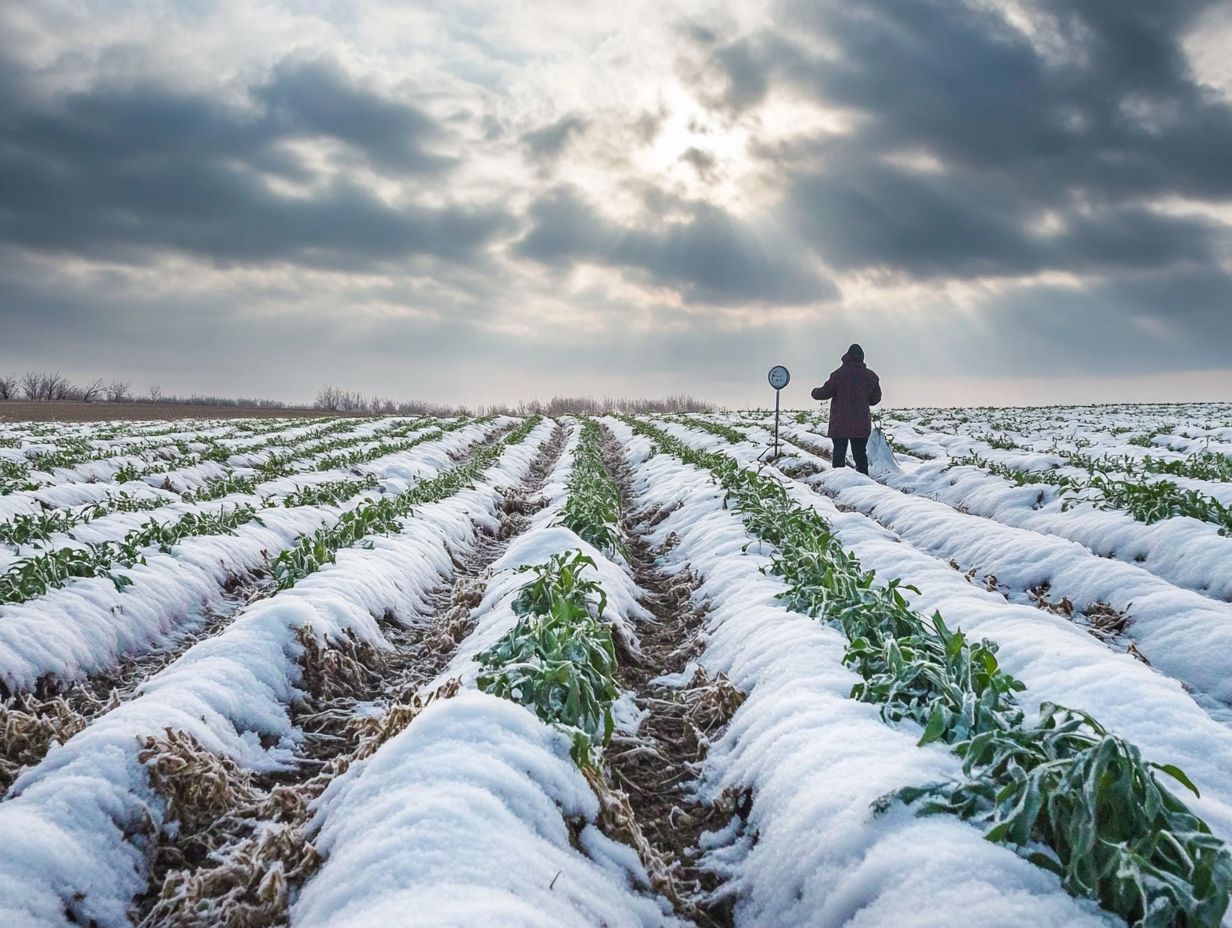
Developing long-term strategies for frost protection is crucial for any gardener dedicated to the health and longevity of their plants during the winter months. By creating a small area with a different climate around your garden, employing insulating soil techniques, and choosing the right plant varieties, you can significantly diminish the risk of frost damage.
Taking a proactive approach and implementing these strategies will safeguard your delicate plants and elevate your overall gardening experience to new heights.
Creating a Microclimate for Your Plants
Creating a microclimate for your plants can significantly enhance their resilience to frost and chilly temperatures, especially in container gardens or more sheltered areas. By thoughtfully positioning your plants under trees or close to walls, you can effectively shield them from harsh winds and temperature fluctuations.
This customized approach is vital for keeping your frost-sensitive plants vibrant. Pay attention to areas that absorb warmth from rocks or pavement; these can offer ideal conditions for growth during the colder months.
Proper plant placement is also key grouping similar species together fosters a beneficial ecosystem and maximizes your available space. Consider using barriers like trellises or fences, which protect against gusts while allowing some translucence for light.
Successful strategies often include gardens layered with tall plants serving as windbreaks or using cold frames to capture sunlight. These setups will extend your growing season and lead to healthier produce come harvest time.
Implementing Sustainable Practices
Implement sustainable practices in your garden for effective frost protection! Your plants will thrive with long-lasting health and resilience.
Techniques like mulching not only insulate the soil but also enhance overall soil health. This creates a nurturing environment for your tender plants.
By using these sustainable methods in your gardening routine, you can enjoy benefits that extend far beyond frost season.
Utilizing natural pest control methods, such as attracting beneficial insects, helps maintain a balanced ecosystem. This approach reduces the reliance on harsh chemicals.
Efficient watering techniques, like drip irrigation, ensure that water reaches the roots directly. This minimizes evaporation and promotes healthier growth.
By embracing these eco-friendly strategies, you shield your plants from frost. You also contribute to a more sustainable environment.
This holistic approach keeps your garden vibrant and thriving throughout the year, ultimately enhancing biodiversity and supporting the well-being of both plants and local wildlife.
Frequently Asked Questions
What are some common ways to protect crops from freezing?
Common ways to protect crops from freezing include using row covers, mulch, and implementing methods to protect your plants from frost.
How do row covers help protect crops from freezing?
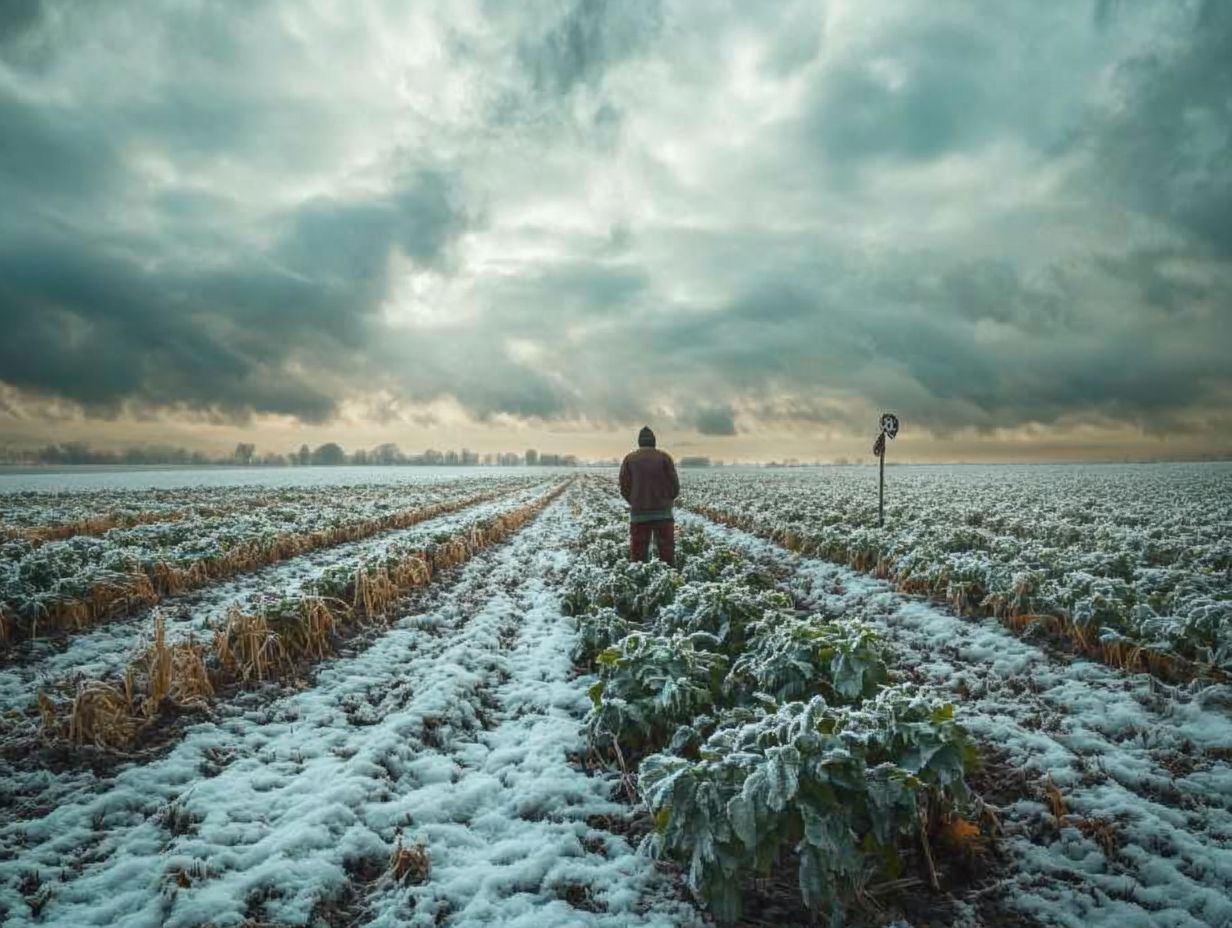
Row covers act as a physical barrier between the crops and freezing temperatures. They trap heat and reduce the impact of frost.
What type of mulch should I use to protect my crops from freezing?
Organic mulch, such as straw or leaves, is best for protecting crops from freezing as it provides insulation and retains heat. Additionally, learning how to protect your crops from heavy snow can further enhance your crop’s resilience during harsh winters.
Can I use water to protect my crops from freezing?
Yes, water can be used to protect crops from freezing by creating a layer of ice around the plants that acts as insulation against the cold temperatures.
Do I need to cover my crops every time there is a freeze warning?
Yes! Always cover your crops during a freeze warning. Even a light frost can harm sensitive plants!
Should I remove the covers after the freeze has passed?
It is important to remove the covers after the freeze has passed to allow sunlight and air to reach the plants and prevent them from becoming too warm.



